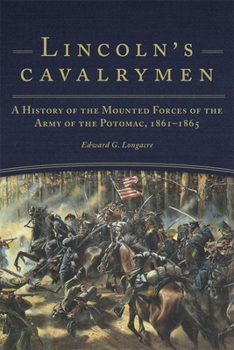Lincoln's Cavalrymen: A History of the Mounted Forces of the Army of the Potomac, 1861-1865
Select Format
Select Condition 
Book Overview
Lincoln's Cavalrymen describes the organizational, administrative, and operational history of the mounted arm of "Mr. Lincoln's Army." Historian Edward G. Longacre consulted at least fifty manuscript collections pertaining to general officers of cavalry, as well as the unpublished letters and diaries of more than 450 officers and enlisted men, representing almost every mounted unit in the Army of the Potomac. The result is the most comprehensive history of the Union cavalry to date. It covers the gamut of cavalry life-not only field operations but also the recruiting, organizing, mounting, remounting, equipping, training, tactical instruction, and war-long support of this critical branch of the nineteenth-century army. The book vividly portrays the cavalry's most influential commanders and assesses the depth and quality of its leadership. Longacre also seeks to place the cavalry in the context of the army and the war effort as a whole. Edward G. Longacre is the author of numerous articles and twenty-four books on the Civil War, including The Cavalry at Gettysburg, winner of the Fletcher Pratt Award for best nonfiction book on the Civil War, and Gentleman and Soldier: A Biography of Wade Hampton III, winner of the Douglas Southall Freeman History Award.
Format:Paperback
Language:English
ISBN:0806142294
ISBN13:9780806142296
Release Date:February 2012
Publisher:University of Oklahoma Press
Length:504 Pages
Weight:1.65 lbs.
Dimensions:1.2" x 6.0" x 9.0"
Customer Reviews
2 ratings
Three Years to Make a Cavalryman
Published by Thriftbooks.com User , 17 years ago
Longacre rightly refutes, with evidence the myth of "it takes three years to make a cavalryman." A statement made against forming volunteer cavalry regiments then, and carried on to this day simply because Brandy Station happened 3 years into the war. While it may have taken 3 years on the plains to make a "good cavalryman," active service in war is make-or-break, and Longacre shows that the Federal cavalry was 'making' it in 1862, long before Brandy Station. The Federal cavalry, in fact, gave as good as it got as evidenced in the Antietam and Peninsula campaigns. What took three years was organization and leadership to finally gain some competence - longer still to deal with misuse and waste. Longacre gives the Federal Cavalry it's due and rightly credits them for the fighting force they were every bit capable of being, long before Brandy Station - if only someone had see it then.
The Definitive Volume!
Published by Thriftbooks.com User , 19 years ago
Edward G. Longacre is one of the best known and most prolific military historians currently researching and publishing on the American Civil War. He has authored more than a dozen articles and no less than a dozen books on the conflict, including biographies of Generals John Buford, Joshua Chamberlain, Henry J. Hunt, and George E. Pickett. His latest effort, Lincoln's Cavalrymen, is the first comprehensive study devoted exclusively to the mounted (both cavalry and horse artillery) forces of the Army of the Potomac. Only two other books have even attempted the scope of examination provided by Lincoln's Cavalrymen - Charles D. Rhodes' History of the Cavalry of the Army of the Potomac (Hudson-Kimberly Publishing Company, 1900) and Stephen Z. Starr's three-volume Union Cavalry in the Civil War (Louisiana State University Press, 1979-84). Unlike these volumes, Longacre provides a more complete picture, by describing the organizational, administrative, and operational history of the cavalry forces of the Army of the Potomac. Rather than merely focusing on their field operations, Lincoln's Cavalrymen also examines the whole spectrum of life in the Union cavalry, including the recruiting, equipping, mounting, training, and organizing of these forces. Longacre believes that Union cavalry has been unfairly characterized as a force which was inept and which struggled to gain competence. At the same time, Confederate cavalry has been portrayed as qualitatively superior, but ultimately weakened by attrition as the war progressed. Therefore, the Union cavalry superiority at the end of the war has been explained as Confederate weakness rather than Union strength. On the contrary, Longacre argues that, while Union cavalry did initially suffer from a shortage of experienced officers and was handicapped by the belief that volunteer cavalry could not be properly trained in a short period of time, by 1863, Union cavalry was qualitatively equal to Confederate cavalry. By 1864, the Union had achieved superiority not only in numbers and firepower (due to the use of repeating carbines), but had also achieved qualitative superiority. Longacre has consulted a wealth of primary sources over the 25-year period during which he has researched this volume. In addition to the traditional published sources, he examined 400 (by his own count) collections of letters, diaries, and memoirs written by Union officers and enlisted men from various mounted units in the Army of the Potomac. Lincoln's Cavalrymen includes 65 single-spaced pages of endnotes, as well as a 51-page bibliography of primary and secondary sources. This volume is highly recommended and would be useful for scholars of the cavalry and/or the American Civil War.





